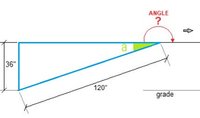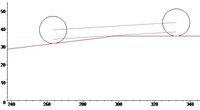As an electrician, we do learn some harder aspects of math, but this one is not our thing.
I was wondering if there in an engineer (or mathematician) in here who could figure this out?
I have a scissor lift that I need to drive up a 10' custom built steel ramp to the bed of a pick-up truck. The truck's bed is 36" above grade. Any ideas about the angle I would need to prevent high-centering at the reflex angle (in RED in attached drawing)?
See drawing, and Thanks to anyone who has this type of expert knowledge!
I was wondering if there in an engineer (or mathematician) in here who could figure this out?
I have a scissor lift that I need to drive up a 10' custom built steel ramp to the bed of a pick-up truck. The truck's bed is 36" above grade. Any ideas about the angle I would need to prevent high-centering at the reflex angle (in RED in attached drawing)?
See drawing, and Thanks to anyone who has this type of expert knowledge!



